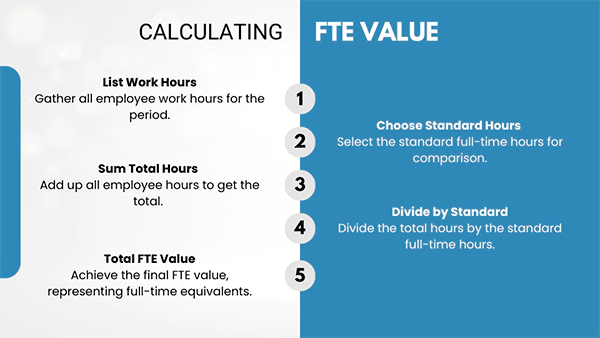Have you ever wondered how companies compare the workload of a part-time employee with that of a full-time staff member?
This is where the concept of FTE, or Full-Time Equivalent, comes into play. It provides a clear measure that translates different working hours into a common and standardized unit, making workforce planning easier to understand and manage.
By using FTE, businesses efficiently allocate resources, track productivity, and plan budgets more effectively, which makes it highly crucial to learn this impactful concept.
Whether you’re a student, HR professional, or business owner, you can learn FTE meaning, its calculator procedures, purposes, and advantages in this discussion.
What is FTE Meaning?

FTE means Full-time equivalent, which is an organizational way to measure the number of employees working equivalent to full-time workers in a firm. In simple terms, it is the group of all employees who work non-full-time but work cumulatively equivalent to the full-time workers, which makes it highly essential in analyzing and comparing the work done by all employees.
This helps in managing the operational needs, optimizing staffing capacity, and eradicating financial and functional inefficiencies. It can be calculated by standardized payroll service providers such as Managetrix Payroll HR services, which simplifies payroll functions with utmost accuracy.
After discussing the FTE meaning, let’s understand how it works and the general procedure of calculating it.
Suggested Reads: Imputed Income Explained: Meaning, Examples, and Tax Implications
How to Calculate FTE?
To calculate FTE, you need to follow a few simple steps. These steps have been described below with corresponding explanation and example in the subsequent part of the discussion.

Step 1: Convert the hours worked by part-time employees to a full-time equivalent scale.
Step 2: Now, calculate the total number of hours the full-time employees have worked in a month.
Step 3: Add the number of hours worked by part-time employees in step 1 and by full-time employees in step 2.
Step 4: Now divide the total number of hours derived in step 3 by the total hours in the given pay period.
You will understand this process more thoroughly through the following example.
Example of FTE Calculation
To make you understand FTE calculation well, here is a step-wise example of it with sample figures and specimen designations.
Step 1: Determine standard full-time work hours per year
Suppose your firm has a 38-hour workweek. Multiply 38 hours by 52 weeks (38×52)= 1,976 hours per year.
Step 2: List Employees and Their Weekly Hours
- Full-time Engineer: 38 hours
- Full-time Designer: 38 hours
- Part-time Analyst: 19 hours
- Part-time Support Staff: 9.5 hours
- Engineer and Designer each work 1,976 hours/year, total = 3,952 hours
- Analyst: 19 × 52 = 988 hours
- Support staff: 9.5 × 52 = 494 hours
- Total annual hours = 3,952 + 988 + 494 = 5,434 hours
Step 3: Calculate FTE
Divide total hours (5,434) by standard full-time hours (1,976):
5,434 ÷ 1,976 ≈ 2.75 FTE
Step 4: Interpretation of the Sample
The company employs 4 people, but the total workload equals approximately 2.75 full-time employees.
FTE Calculator
To further simplify your efforts in calculating it, we are providing an automated calculator.
Full-Time Equivalent (FTE) Calculator
How to Use the FTE Calculator?
Step 1: In this FTE calculator tool, you need to put the desired values as mentioned below:
- Number of Full-Time Employees
- Number of Part-Time Employees
- Full-Time Weekly Hours
- Average Part-Time Weekly Hours
Step 2: Click on “Calculate FTE” to get the numerical value of full-time equivalent.
Comparison Between FTE and Full-time Employees
The FTE meaning differs a lot from that of a full-time employee. You need to understand this variance to comprehend the meaning of full-time equivalent holistically.
For this, we have provided a detailed table for FTE vs. Full-time Employees.
| S. No | Difference | Full-time equivalent | Full-time employees |
| 1 | Definition | A cumulative unit to measure workforce capacity. | A means of measuring full-time horse workers. |
| 2 | Formula | Total hours that all employees have worked/ standard hours. | Based on the schedule of the full-time employees. |
| 3 | Where is it used | Productivity measurement, budgeting, and workforce planning. | Payroll management and disbursal of benefits. |
| 4 | Essence | Can be part-time, contractual, or full-time. | Only full-time employees. |
| 5 | Example | 1 employee working full-time hours OR 2 employees working half-time hours. | Usually 30–40 hours a week, as decided by the company policy. |
What is the Purpose of FTE?

The FTE serves many purposes, such as systematic budgeting, staffing optimization, productivity assessment and forecasting labor cost, and managing resource allocation. Along with this, it serves several other objectives as well, which are as follows:
- Project Time Estimation: FTE helps the managers estimate the total hours required for project completion by converting team availability into full-time schedules.
- Budget Calculation: Budget analysts use FTE to accurately calculate the amount of money needed to allocate for workforce-related project expenses.
- Staffing Requirements: Business owners employ FTE to determine the number of full-time and part-time employees needed for company or project success.
- Productivity Assessment: Using FTE enables businesses to measure employee productivity based on actual hours worked relative to full-time benchmarks.
- Labor Cost Forecasting: FTE calculation provides a foundation for estimating labor costs and ensures resources are allocated correctly within budget limits.
- Resource Allocation Decisions: FTE reveals whether a goal or project is financially feasible by modeling resource needs and associated costs.
These purposes correspond to certain advantages which are to be discussed in this discussion.
Why FTE is Important for Businesses?
Learning FTE meaning is important to evaluate workload and demand, manage HR operations, enhance headcount analysis, and ensure balanced workload.
Here are some notable advantages of FTE that you must stay aware of.
- Checking Part-Time Workforce Productivity: Calculating FTEs provides insight into the efficiency and contributions of part-time workers by analyzing the tasks they have completed.
- Recognizing Financial Impact: Employees typically earn less and receive fewer benefits as well, and the FTE calculation shows their real costs to the business.
- Understanding Operations: FTE evaluation helps companies comprehend how part-time work impacts overall effectiveness and the financial health of their business.
- Evaluating Workload and Compensation: Project managers and business analysts utilize FTE to gauge the workload and to determine the requirements for payroll.
- Balancing HR Management: The balance of HR Management FTE gives fractional value (e.g., 0.5) for part-time workers in order to calculate their compensation in comparison to full-time workers.
- Enhancing Headcount Analysis: FTE facilitates easier comparison of the size of the workforce against earnings or outputs.
- Improving Project Management: Utilizing FTE makes it easier to estimate labor requirements and assists in determining the best required mixture of part-time and full-time employees.
- Assessing Role-Based Capacity: FTE helps in grouping employees according to their skills or roles to better manage resource allocation and task assignments.
- Ensuring Balanced Workload: Planning based on FTE ensures a fair task allocation that matches the capacities of employees, thus preventing over- or underutilization of the skill set of the employee.
Conclusion
The above discussion has underscored FTE meaning as a key workforce metric to standardize employee work hours into full-time units through a scale of work hours in a month. This helps organizations accurately assess labor capacity, optimize staffing needs, manage payroll costs efficiently, and improve productivity analysis. Quantifying it caters to informed decision-making in human resource planning and financial management.
Next Read: What is the LOP Full Form? Holistically Elucidated
FAQ
1. How to calculate FTE productivity?
Ans: To calculate FTE productivity, add work hours by all employees, divide by standard full-time hours (e.g., 2,080/year), to measure workforce capacity and estimate productivity efficiently.
2. What does FTE mean in finance?
Ans: In finance, FTE means total workforce labor as full-time units, used in budgeting, cost analysis, and financial forecasting to align payroll expenses and workforce planning.
3. What does FTE stand for in education?
Ans: FTE in education measures student enrollment or staff workload as full-time units, helping schools standardize resources and examine faculty or student ratios.
4. What does mean 1 FTE?
Ans: 1 FTE means one employee working full-time hours, which is generally 40 hours per week or 2,080 hours annually, which represents a standard full-time workload.